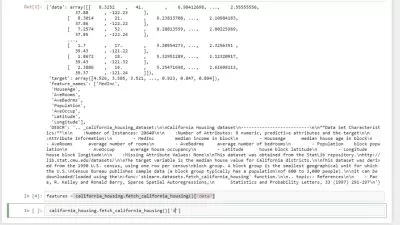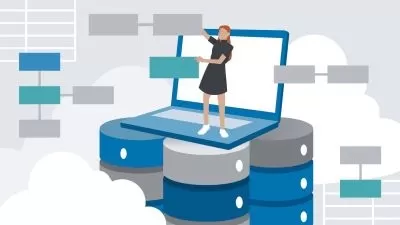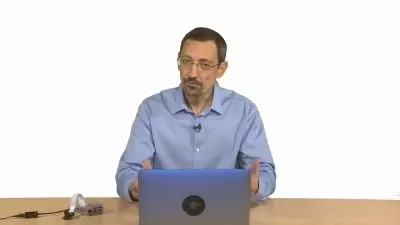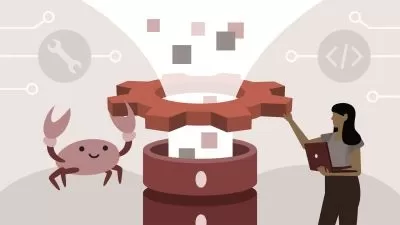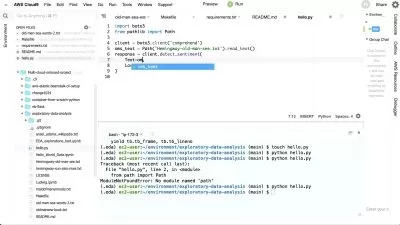Machine Learning, Data Science and Generative AI with Python
Sundog Education by Frank Kane,Frank Kane,Sundog Education Team
18:45:32
Description
Complete hands-on machine learning and GenAI tutorial with data science, Tensorflow, GPT, OpenAI, and neural networks
What You'll Learn?
- Build artificial neural networks with Tensorflow and Keras
- Implement machine learning at massive scale with Apache Spark's MLLib
- Classify images, data, and sentiments using deep learning
- Make predictions using linear regression, polynomial regression, and multivariate regression
- Data Visualization with MatPlotLib and Seaborn
- Understand reinforcement learning - and how to build a Pac-Man bot
- Classify data using K-Means clustering, Support Vector Machines (SVM), KNN, Decision Trees, Naive Bayes, and PCA
- Use train/test and K-Fold cross validation to choose and tune your models
- Build a movie recommender system using item-based and user-based collaborative filtering
- Clean your input data to remove outliers
- Design and evaluate A/B tests using T-Tests and P-Values
Who is this for?
What You Need to Know?
More details
DescriptionUnlock the Power of Machine Learning & AI: Master the Art of Turning Data into Insight
Discover the Future of Technology with Our Comprehensive Machine Learning & AI Course - Featuring Generative AI, Deep Learning, and Beyond!
In an era where Machine Learning (ML) and Artificial Intelligence (AI) are revolutionizing industries across the globe, understanding how giants like Google, Amazon, and Udemy leverage these technologies to extract meaningful insights from vast data sets is more critical than ever. Whether you're aiming to join the ranks of top-tier AI specialists—with an average salary of $159,000 as reported by Glassdoor—or you're driven by the fascinating challenges this field offers, our course is your gateway to an exciting new career trajectory.
Designed for individuals with programming or scripting backgrounds, this course goes beyond the basics, preparing you to stand out in the competitive tech industry. Our curriculum, enriched with over 145 lectures and 20+ hours of video content, is crafted to provide hands-on experience with Python, guiding you from the fundamentals of statistics to the cutting-edge advancements in generative AI.
Why Choose This Course?
Updated Content on Generative AI: Dive into the latest in AI with modules on transformers, GPT, ChatGPT, the OpenAI API, Advanced Retrieval Augmented Generation (RAG), LLM agents, langchain, and self-attention based neural networks.
Real-World Application: Learn through Python code examples based on real-life scenarios, making the abstract concepts of ML and AI tangible and actionable.
Industry-Relevant Skills: Our curriculum is designed based on the analysis of job listings from top tech firms, ensuring you gain the skills most sought after by employers.
Diverse Topics Covered: From neural networks, TensorFlow, and Keras to sentiment analysis and image recognition, our course covers a wide range of ML models and techniques, ensuring a well-rounded education.
Accessible Learning: Complex concepts are explained in plain English, focusing on practical application rather than academic jargon, making the learning process straightforward and engaging.
Course Highlights:
Introduction to Python and basic statistics, setting a strong foundation for your journey in ML and AI.
Deep Learning techniques, including MLPs, CNNs, and RNNs, with practical exercises in TensorFlow and Keras.
Extensive modules on the mechanics of modern generative AI, including transformers and the OpenAI API, with hands-on projects like fine-tuning GPT, Advanced RAG, langchain, and LLMÂ agents.
A comprehensive overview of machine learning models beyond GenAI, including SVMs, reinforcement learning, decision trees, and more, ensuring you have a broad understanding of the field.
Practical data science applications, such as data visualization, regression analysis, clustering, and feature engineering, empowering you to tackle real-world data challenges.
A special section on Apache Spark, enabling you to apply these techniques to big data, analyzed on computing clusters.
No previous Python experience? No problem! We kickstart your journey with a Python crash course to ensure you're well-equipped to tackle the modules that follow.
Transform Your Career Today
Join a community of learners who have successfully transitioned into the tech industry, leveraging the knowledge and skills acquired from our course to excel in corporate and research roles in AI and ML.
"I started doing your course... and it was pivotal in helping me transition into a role where I now solve corporate problems using AI. Your course demystified how to succeed in corporate AI research, making you the most impressive instructor in ML I've encountered." - Kanad Basu, PhD
Are you ready to step into the future of technology and make a mark in the fields of machine learning and artificial intelligence? Enroll now and embark on a journey that transforms data into powerful insights, paving your way to a rewarding career in AI and ML.
Who this course is for:
- Software developers or programmers who want to transition into the lucrative data science and machine learning career path will learn a lot from this course.
- Technologists curious about how deep learning really works
- Data analysts in the finance or other non-tech industries who want to transition into the tech industry can use this course to learn how to analyze data using code instead of tools. But, you'll need some prior experience in coding or scripting to be successful.
- If you have no prior coding or scripting experience, you should NOT take this course - yet. Go take an introductory Python course first.
Unlock the Power of Machine Learning & AI: Master the Art of Turning Data into Insight
Discover the Future of Technology with Our Comprehensive Machine Learning & AI Course - Featuring Generative AI, Deep Learning, and Beyond!
In an era where Machine Learning (ML) and Artificial Intelligence (AI) are revolutionizing industries across the globe, understanding how giants like Google, Amazon, and Udemy leverage these technologies to extract meaningful insights from vast data sets is more critical than ever. Whether you're aiming to join the ranks of top-tier AI specialists—with an average salary of $159,000 as reported by Glassdoor—or you're driven by the fascinating challenges this field offers, our course is your gateway to an exciting new career trajectory.
Designed for individuals with programming or scripting backgrounds, this course goes beyond the basics, preparing you to stand out in the competitive tech industry. Our curriculum, enriched with over 145 lectures and 20+ hours of video content, is crafted to provide hands-on experience with Python, guiding you from the fundamentals of statistics to the cutting-edge advancements in generative AI.
Why Choose This Course?
Updated Content on Generative AI: Dive into the latest in AI with modules on transformers, GPT, ChatGPT, the OpenAI API, Advanced Retrieval Augmented Generation (RAG), LLM agents, langchain, and self-attention based neural networks.
Real-World Application: Learn through Python code examples based on real-life scenarios, making the abstract concepts of ML and AI tangible and actionable.
Industry-Relevant Skills: Our curriculum is designed based on the analysis of job listings from top tech firms, ensuring you gain the skills most sought after by employers.
Diverse Topics Covered: From neural networks, TensorFlow, and Keras to sentiment analysis and image recognition, our course covers a wide range of ML models and techniques, ensuring a well-rounded education.
Accessible Learning: Complex concepts are explained in plain English, focusing on practical application rather than academic jargon, making the learning process straightforward and engaging.
Course Highlights:
Introduction to Python and basic statistics, setting a strong foundation for your journey in ML and AI.
Deep Learning techniques, including MLPs, CNNs, and RNNs, with practical exercises in TensorFlow and Keras.
Extensive modules on the mechanics of modern generative AI, including transformers and the OpenAI API, with hands-on projects like fine-tuning GPT, Advanced RAG, langchain, and LLMÂ agents.
A comprehensive overview of machine learning models beyond GenAI, including SVMs, reinforcement learning, decision trees, and more, ensuring you have a broad understanding of the field.
Practical data science applications, such as data visualization, regression analysis, clustering, and feature engineering, empowering you to tackle real-world data challenges.
A special section on Apache Spark, enabling you to apply these techniques to big data, analyzed on computing clusters.
No previous Python experience? No problem! We kickstart your journey with a Python crash course to ensure you're well-equipped to tackle the modules that follow.
Transform Your Career Today
Join a community of learners who have successfully transitioned into the tech industry, leveraging the knowledge and skills acquired from our course to excel in corporate and research roles in AI and ML.
"I started doing your course... and it was pivotal in helping me transition into a role where I now solve corporate problems using AI. Your course demystified how to succeed in corporate AI research, making you the most impressive instructor in ML I've encountered." - Kanad Basu, PhD
Are you ready to step into the future of technology and make a mark in the fields of machine learning and artificial intelligence? Enroll now and embark on a journey that transforms data into powerful insights, paving your way to a rewarding career in AI and ML.
Who this course is for:
- Software developers or programmers who want to transition into the lucrative data science and machine learning career path will learn a lot from this course.
- Technologists curious about how deep learning really works
- Data analysts in the finance or other non-tech industries who want to transition into the tech industry can use this course to learn how to analyze data using code instead of tools. But, you'll need some prior experience in coding or scripting to be successful.
- If you have no prior coding or scripting experience, you should NOT take this course - yet. Go take an introductory Python course first.
User Reviews
Rating
Sundog Education by Frank Kane
Instructor's CoursesFrank Kane
Instructor's CoursesSundog Education Team
Instructor's Courses
Udemy
View courses Udemy- language english
- Training sessions 133
- duration 18:45:32
- English subtitles has
- Release Date 2024/07/07






